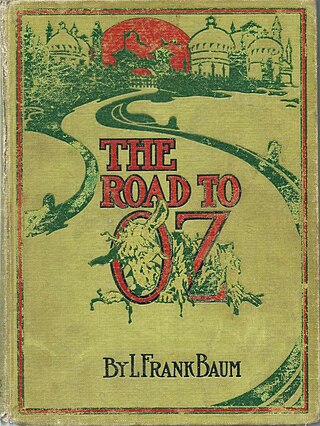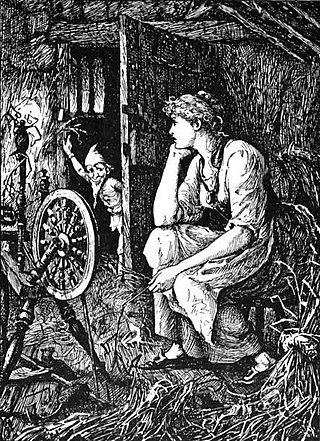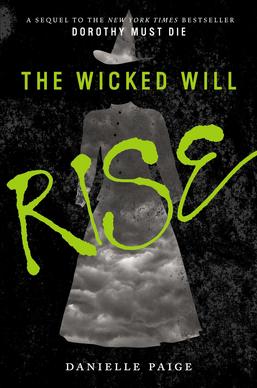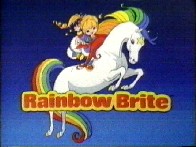Related Research Articles

The Road to Oz is the fifth book in L. Frank Baum's Oz series. It was originally published on July 10, 1909 and documents the adventures of Dorothy Gale's fourth visit to the Land of Oz. It was followed by The Emerald City of Oz (1910).

The Land of Oz is a magical country introduced in the 1900 children's novel The Wonderful Wizard of Oz written by L. Frank Baum and illustrated by W. W. Denslow.

The StoryTeller is a live-action/puppet television series that originally aired in 1987 and which was created and produced by Jim Henson.

"Allerleirauh" is a fairy tale recorded by the Brothers Grimm. Since the second edition published in 1819, it has been recorded as Tale no. 65. Andrew Lang included it in The Green Fairy Book.

The Langs' Fairy Books are a series of 25 collections of true and fictional stories for children published between 1889 and 1913 by Andrew Lang and his wife, Leonora Blanche Alleyne. The best known books of the series are the 12 collections of fairy tales also known as Andrew Lang's "Coloured" Fairy Books or Andrew Lang's Fairy Books of Many Colors. In all, the volumes feature 798 stories, besides the 153 poems in The Blue Poetry Book.
The Blue Mountains is a fairy tale. Andrew Lang included it in The Yellow Fairy Book (1894), but provided no bibliographical information and its origin remains obscure.
"The Bronze Ring" is the first story in The Blue Fairy Book by Andrew Lang. According to Lang's preface, this version of this fairy tale from the Middle East or Central Asia was translated and adapted from TraditionsPopulaires de l'Asie Mineure by Carnoy et Nicolaides.

The Prince Who Worked as Satan's Servant and Saved the King from Hell is a Lithuanian fairy tale collected by German linguists August Leskien and Karl Brugmann. Andrew Lang included it in The Grey Fairy Book under the title The Magician's Horse.

The Legend of Snow White is a Japanese anime series produced by Tatsunoko Production, based on the 1812 European fairy tale. Directed by Kunitoshi Okajima, the series premiered on NHK on 6 April 1994 and ran for 52 episodes until its conclusion on 29 March 1995.

"The King of the Golden Mountain" is a German fairy tale collected by the Brothers Grimm in Grimm's Fairy Tales.

The Land of Ev is a fictional country in the Oz books of L. Frank Baum and his successors. The country was first visited in Baum's third Oz novel, 1907's Ozma of Oz, and was the first of Baum's countries that surround the Land of Oz. This book introduced the Nome King, a recurring villain who lives underground beneath the Land of Ev.

The Wicked Will Rise is a young adult novel by Danielle Paige, and the sequel to the 2014 book Dorothy Must Die. It was published by HarperCollins on March 30, 2015. It continues the story of high school girl Amy Gumm in her mission to assassinate Dorothy Gale, who has become twisted and evil.

Rainbow Brite is an animated series based on Hallmark's media franchise of the same name, that ran from 1984 to 1986. Produced by DIC Enterprises with animation provided by Japanese TMS Entertainment, the show began as a part of DIC's Kideo TV syndicated anthology package. In this series, Rainbow Brite uses her magical belt to protect the colors of Rainbowland from the bumbling Murky & Lurky.

Ileana Simziana or Ileana Sînziana is a Romanian fairy tale collected and written down by Petre Ispirescu between 1872 and 1886. It tells the story of an unnamed youngest daughter of an emperor, who dresses up as a man, goes to serve another emperor and rescues the titular princess Ileana. During a quest of obtaining the Holy Water she is hit by a curse of a monk that causes her to transform into a man - Făt-Frumos, who marries Ileana in the happy ending.
The Tale of the Woodcutter and his Daughters is an Egyptian folktale related to the international cycle of the Animal as Bridegroom. It mostly follows subtype ATU 425D, "The Vanished Husband", which segues into tale type ATU 425B, "The Son of the Witch", with the heroine's tasks for the supernatural husband's mother - subtypes of the more general type ATU 425, "The Search for the Lost Husband".
The White Wolf is a French-language fairy tale collected from Wallonia by authors Auguste Gittée and Jules Lemoine. It is related to the international cycle of the Animal as Bridegroom or The Search for the Lost Husband, wherein a human princess marries a prince under an animal curse, loses him and has to search for him.
The Beautiful Palace East of the Sun and North of the Earth is a Swedish folktale collected from Smaland by Swedish folktale collectors George Stephens and Gunnar Olof Hyltén-Cavallius. It features versions of the swan maiden, a mythic female character that alternates between human and animal shapes.
Donotknow is a Russian fairy tale (skazka) collected by folklorist Alexandr Afanasyev in his three-volume compilation Russian Fairy Tales. The tale was also translated as "Know Not" by Jack V. Haney. It deals with a friendship between a merchant's son and a magic horse that are forced to flee for their lives due to the boy's stepmother, and reach another kingdom, where the boy adopts another identity by only uttering the words "Ne znay".
References
- ↑ Rainbow War at Expo 86-YouTube
- ↑ "Rainbow War" (PDF). BRC Imagination Arts. Archived from the original (PDF) on 2013-12-19.
- ↑ Ryan Stiles is Rainbow War-YouTube
- ↑ WorldCat
- ↑ Pyramid Media